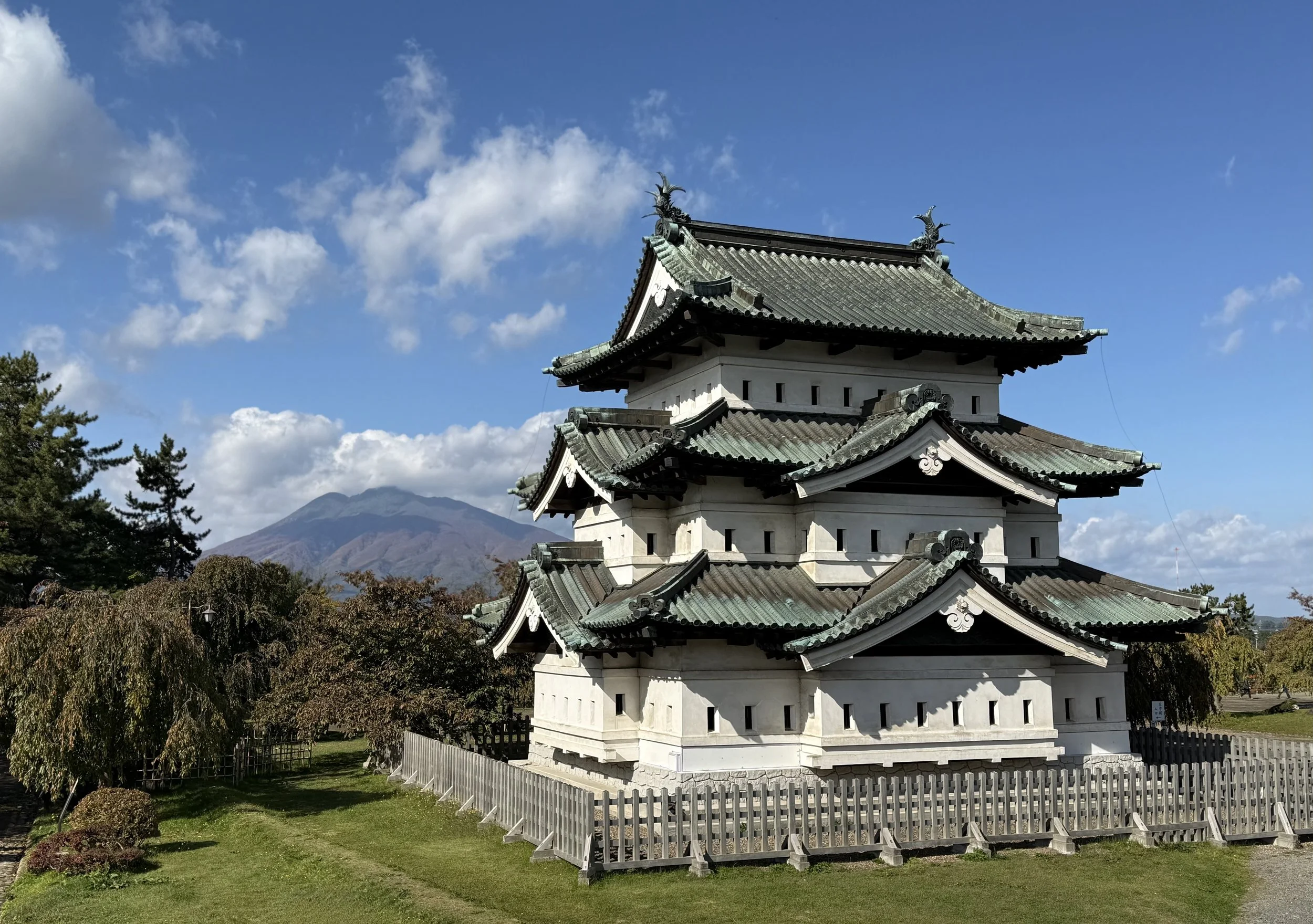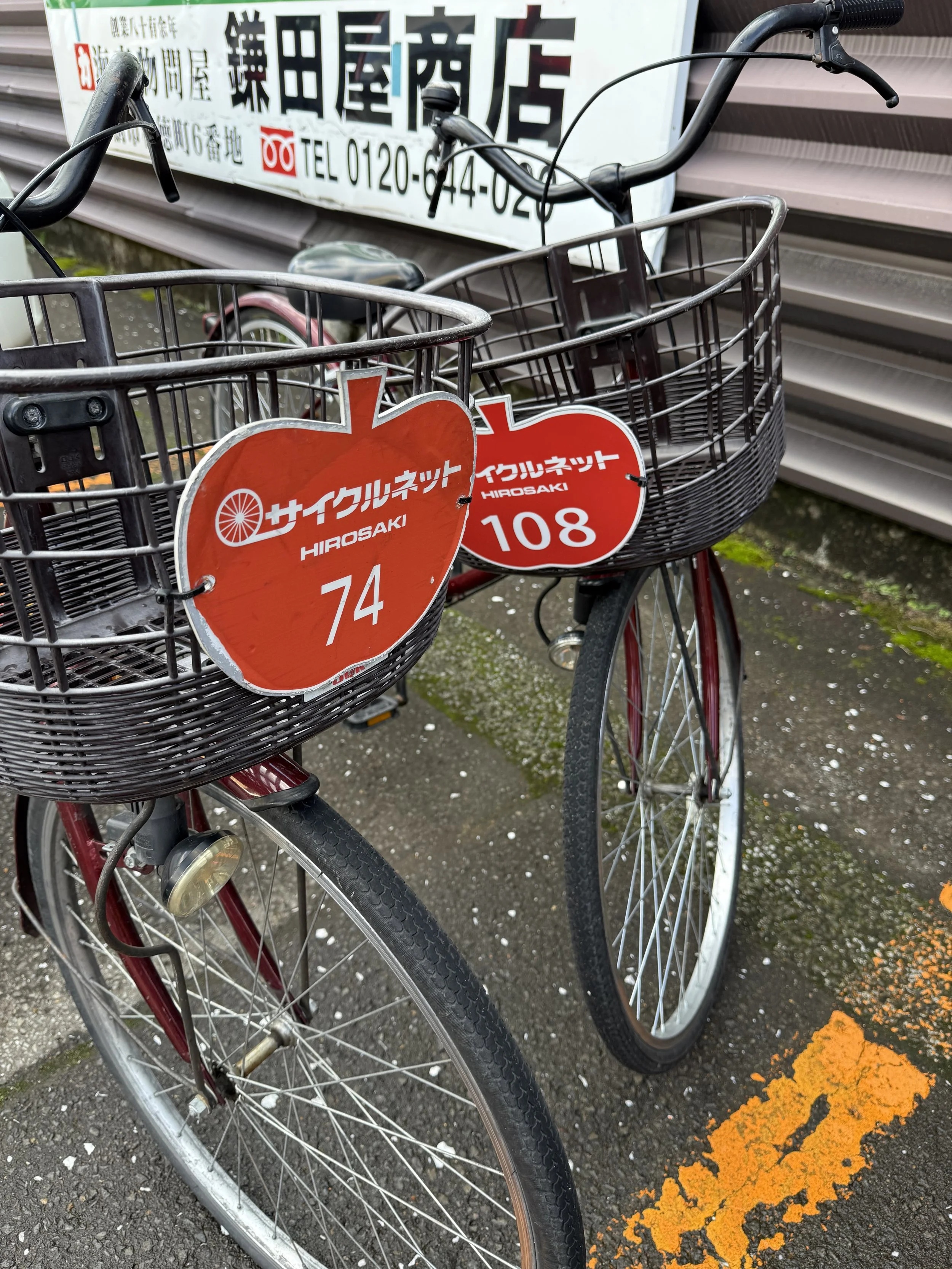Aomori, Japan
We arrived at the Port of Aomori early in the morning. The air was cool and misty, and a faint rainbow stretched across the bridge as we docked. It looked like a promising start to the day.
I joined a tour bound for Hirosaki, about an hour inland from the port. The drive passed through quiet farmland and low mountain scenery, with apple orchards visible along the road. The guide explained that Aomori is Japan’s main apple-growing region, producing more than half of the country’s total crop. The bright red Sun Fuji is the most famous variety, and farmers protect the fruit by wrapping each apple in paper to keep the skin unblemished. Juice and cider are sold almost everywhere, and many bakeries specialize in fresh apple pies.
Seafood is also central to the area’s identity. Scallops from Mutsu Bay are known for their sweetness, and tuna caught off the port of Ōma often sells for record prices at Tokyo’s fish markets. In 2019, a single bluefin tuna from Ōma sold for more than ¥330 million yen (over three million U.S. dollars) at auction, and in 2020 another sold for nearly ¥200 million yen. These headline-grabbing sales highlight just how prized Aomori’s tuna is across Japan. The local economy still depends heavily on these two products — apples from the orchards and fish from the sea.
Hirosaki Nebuta Museum
Our first stop in Hirosaki was a small museum near Hirosaki Castle that focuses on the city’s version of the Nebuta Festival. It is much smaller than the main museum in Aomori City but offers a more personal look at the local traditions that shape the event. Admission costs ¥600 for adults and ¥300 for children, and the museum is open daily from 9:00 a.m. to 5:00 p.m.
Inside, large paper floats glowed in a dimly lit hall. Each figure was built over a wire frame, covered with paper, and painted by hand. The displays change throughout the year to highlight different designs and techniques. The staff gave a short demonstration of the festival music and explained how the drums, flutes, and dancers work together during the celebration. Visitors were invited to take turns striking the taiko drum, and a musician performed on the shamisen, a three-stringed instrument that gives the festival its distinctive sound.
In another section of the building, local artisans demonstrated how they make wooden toys and hand-painted ceramics, both of which are sold in small shops around the region. The process was simple but detailed, and visitors could watch as each piece took shape. Small finished items were available for purchase in the museum’s gift shop, including carved dolls, ceramic dishes, and miniature float ornaments. The shop also carried postcards, keychains, and locally made snacks that make easy souvenirs.
It was a compact museum, easy to see in less than an hour, but it offered a close view of the craftsmanship and music that define Hirosaki’s version of the Nebuta Festival.
Hirosaki Castle
Hirosaki Castle was built in the early 1600s by the Tsugaru clan and is one of only twelve original castles still standing in Japan. The three-story keep sits in the center of Hirosaki Park, a public area that spans nearly 50 hectares. The castle is surrounded by moats and earthen walls that once served as its main defenses. Today, the setting feels calm and open, with tree-lined paths, arched bridges, and still ponds that reflect the tower above.
The park is most famous for its cherry blossoms, which attract more than two million visitors each spring. Over two thousand trees bloom across the grounds, turning the moats and walkways into a sea of pink and white. During the festival, visitors can rent small boats to paddle along the moat beneath the petals. Outside of spring, the park remains worth visiting. Summer brings dense greenery, autumn covers the grounds in red and gold, and winter leaves the castle surrounded by snow.
Several original gates, turrets, and stone walls still stand around the park, along with plaques in Japanese and English explaining the site’s history. The main keep is smaller than many of Japan’s other castles but remains well preserved and approachable.
In 2015, the entire tower was carefully moved about 70 meters from its original stone base so that the foundation could be repaired. The move was done without dismantling the structure — a rare engineering project in Japan. Once restoration is complete, the keep will be returned to its original position.
The castle grounds are open daily, with the inner area and tower accessible from late March through November. Admission to the keep and inner citadel is ¥320 for adults and ¥100 for children. Entry to the park itself is free year-round.
Around Aomori
Nebuta Museum Wa Rasse
This is the main Nebuta museum. It showcases full-sized floats from past Aomori Nebuta Festivals, which are held every August 2–7. The building itself is striking, with its red lattice design meant to resemble traditional festival curtains.
Inside, the museum displays four to five giant illuminated floats that can reach up to 9 meters wide and 5 meters tall. Visitors can walk right up to them, learn about how they’re constructed from washi paper and wire, and watch short video presentations of the festival.
There’s also an interactive zone where you can listen to the “haneto” festival chants, play the taiko drums, and see footage of the floats moving through the streets at night.
Admission:
¥1,000 for adults, ¥600 for high school students, ¥450 for elementary/middle school students.
Open daily 9:00 a.m. to 7:00 p.m. (May–August), and 9:00 a.m. to 6:00 p.m. (September–April).
ASPAM Observation Tower
The triangular tower near the waterfront has an observation deck with views of the city and surrounding mountains. Inside are souvenir shops, small food stalls, and exhibits featuring regional products like apples, scallops, and sake.
A-Factory and Aomori Bay Area
Across from Aomori Station, A-Factory sells apple juice, cider, sweets, and jams made from local fruit. The complex connects to the pedestrian walkway under the Aomori Bay Bridge, a good spot for photos of the harbor.
Furukawa Fish Market and Nokke-don
Just a few minutes’ walk from Aomori Station, Furukawa Fish Market is a must for seafood lovers. The market’s main draw is the “Nokke-don,” a build-your-own seafood bowl. Visitors purchase a set of meal tickets (starting around ¥1,500) and trade them for toppings from different stalls — everything from tuna and scallops to salmon roe and crab. Each bowl ends up unique, and it’s one of the best ways to sample local seafood without a high price tag. Most vendors accept cash only.
Seiryu-ji Temple and Showa Daibutsu
A short drive from the city center, Seiryu-ji Temple is home to the Showa Daibutsu, one of Japan’s largest seated bronze Buddha statues. The temple grounds are surrounded by forest and are open year-round.
Local Tips:
Most city buses and small shops in Aomori and Hirosaki prefer cash, though IC cards like Suica and PASMO are accepted on JR trains. Both cities are compact enough to explore on foot, and taxis are easy to find near stations and major attractions.
When to Visit
Aomori’s seasons each offer something different. Spring (late April to early May) brings cherry blossoms to Hirosaki Castle, while summer (August 2–7) is when the Aomori Nebuta Festival lights up the streets with floats and drums. Autumn (October to early November) is ideal for fall colors in Oirase Gorge and the Lake Towada area. Winter is cold and snowy but beautiful — and a good time to try hot local dishes and apple desserts in the city cafés.





